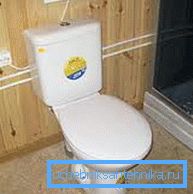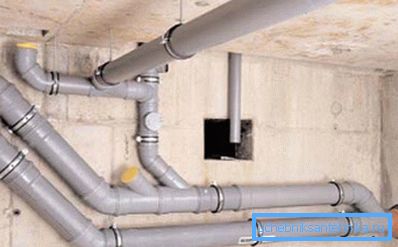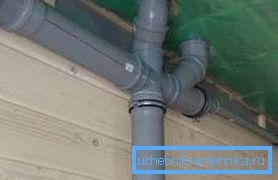Installation of sewage in a private house
Installation of sewage is considered one of the most important stages during the construction or repair of the house.
Modern sewage is a complex complex, which consists of several main parts:
- internal and external sewage;
- special treatment facilities.

Installation of internal sewage
The installation of this type of sewage system consists in the installation of a sewer riser and a special sewage pipe, in the future it is necessary to connect all sanitary appliances to the previously installed riser.
For this type of work using pipes made of polypropylene (diameter from 50 to 100 mm). This material is distinguished by its strength, it is able to withstand the temperature of the liquid up to 80 degrees Celsius.
Installing sewage pipes with your own hands will require from you not only theoretical knowledge, but also practical skills.

One hundred millimeter pipe is used to connect the toilet to the riser. To connect a shower cabin, sink, washing machine and dishwasher, use components with a diameter of only 50 mm.
All branches and branches, which are located in the horizontal plane, should be performed by means of special sewer tees or crosses.
How to replace sewer riser
In order to prevent blockages as much as possible, it is forbidden to make turns in the sewer pipeline at right angles. They should be made at an angle of 45 degrees.
In the house, all turns of the sewage system must be equipped with special audits (if there is no access from the nearest plumbing fixture).

In high-rise buildings, sewage audits must be installed across three floors. If the building does not exceed five floors, then the revisions are mounted at the beginning and end of the riser. If the horizontal section of the sewer has a length of more than 12 meters, the installation of the audit is mandatory.
Tip! To avoid unnecessary vacuum in the system, as well as to ensure normal ventilation, the sewer riser must be equipped with a sewer pipe. The diameter of this part of the sewer system does not depend on the diameter of the riser (they should be almost the same).
The pipe is displayed on the roof of the building (the height from the roof surface is at least 50 cm).
The slope of the sewer elements in the apartment is selected according to the diameter of the pipe. If the diameter is 100 mm, then the slope is 0.02; for a diameter of 50 mm, the slope is 0.03.
Installation of sewage
Many property owners are interested in the question, how to install sewer pipes? If you give preference to a large slope, then with increasing angle, the noise of the pipe will noticeably increase during the flushing of sewage.
If the slope has a value of more than 0.15, then the nozzle completely loses the possibility of self-cleaning. This is due to the fact that flow stratification occurs, therefore, viscous fractions simply settle on the walls. After a while, blockages begin to occur.

A large slope is allowed in the apartment in pipes in short sections, where sewage systems are connected to the receivers (the length of the section should not exceed one and a half meters).
Reducing the slope of the sewer pipe will immediately lead to a significant change in the flow rate of wastewater. Normal flow rate is considered - 70 cm per second. In some cases, the installation of the sewer system can be done indoors inside the walls or under the floor, in the future the walls should be reliably concreted and plastered.
To minimize noise, you can perform the following activities:
- wind the pipes with a special soundproof material (experts suggest using fiberglass, you can blow pipes with foam);
- plaster carefully, leaving no voids;
- the thickness of the plaster must be at least 2 cm.
External sewer system

Installation of an outdoor sewage system in a private house should be based on the implementation of the following rules:
- it is recommended to use a hacksaw or a grinder (“Bulgarian”) for cutting off sewer connections. At the site of the saw cut, a small chamfer is removed along the entire circumference of the pipe using a file;
- it must be treated with silicone grease before mounting into the socket of the socket, this will facilitate the installation. To increase the tightness of the entire system, the socket itself is not lubricated;
- the pipe must be inserted into the socket until it stops, then it extends slightly to provide a thermal gap;
- if nozzles with cut-off sockets are mounted, then it is necessary to use fittings for the connection;
- as fasteners to the walls of sewer elements use metal clamps installed in increments equal to ten pipe diameters;
- sewer riser should be mounted every one and a half meters, the distance between the wall and the riser - at least 5 mm;
- clamp must be installed under the socket. The clamp must be securely fixed to avoid moving it during operation. Neighboring mounts can be slightly relaxed to relieve internal stresses in the system.
Sewer pipes
Almost all drainage elements are made of PVC or polyethylene. Materials are not strongly exposed to the negative effects of the environment, have excellent strength characteristics compared with polypropylene. Branch pipes for external sewage are highlighted in orange.

Let's find out how to install sewage in a private house? Installation of any drainage begins with the installation of a sewage treatment plant, namely, a sump or septic tank. After these operations, you can begin to connect the internal sewer system.
The installation of water sewage elements always starts from the side where the water flows.

Tip! Lay the pipes with your own hands with a slope of only 1-2 cm per linear meter of pipe. More accurate values and the order of calculations are presented in the appropriate section of the SNiP.
To prevent sewage elements from being accidentally damaged by a layer of soil, they must be carefully tamped into the trench with sand. A layer of sand should be at least 20 cm under the pipe, on the sides and exactly the same on top of the pipe.
The depth of laying of the external drainage system directly depends on the depth of soil freezing. Naturally, in each region, this depth is different, because it depends on climatic conditions.
The pipe should be laid 0.5 meters above the freezing depth. There is no need to lay down the communications below, since in a normal state the nozzles are empty, so there is simply nothing to freeze inside.
It is also known that the wastewater at the outlet of the pipes of the room has a temperature of at least 15 degrees Celsius, therefore, they are capable of quite easily washing off the layer of small frost formed in the pipe.
Installation of drainage pipes
The installation instructions for sewer pipes are not very complicated, so you can handle this operation yourself. In the European part of Russia, pipe laying is carried out to a depth of half a meter. If the drainage element passes under the carriageway, then the laying depth must be at least 70 cm. This will avoid damage from traffic passing over the pipes.

If the outdoor water sewage system is of short length, then it is recommended to install inspection wells every 25 meters. These wells also need to be installed in places where the pipe is turning or in places where the depth and laying depth are different.
Conclusion
In conclusion, we note that the implementation of the rules outlined in the article can make installation as easy as possible and increase the reliability of the sewage system being operated. In the presented video in this article you will find additional information on this topic.